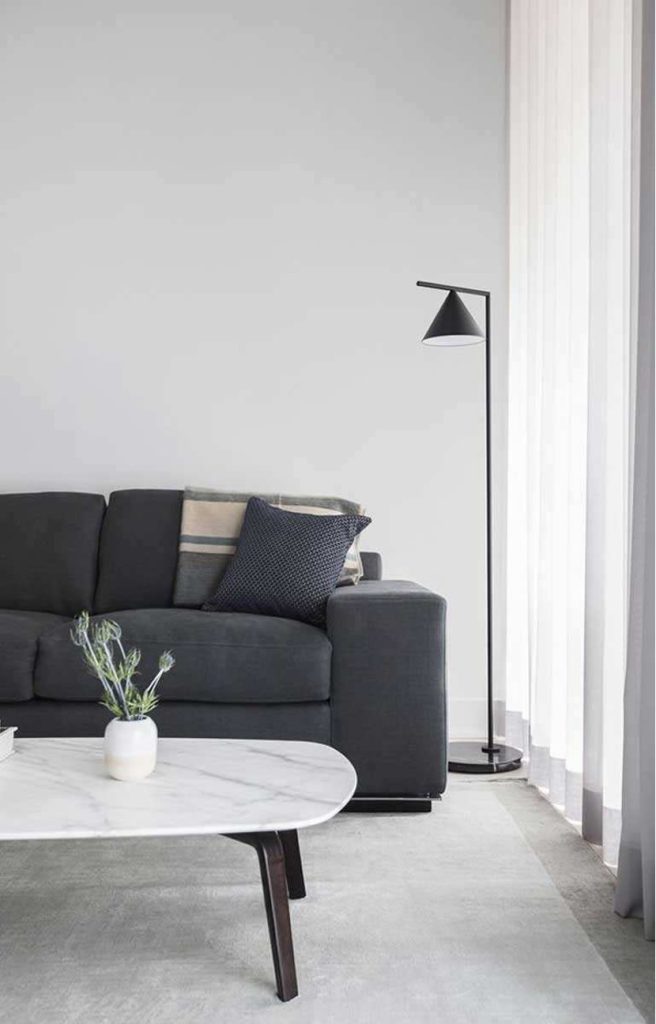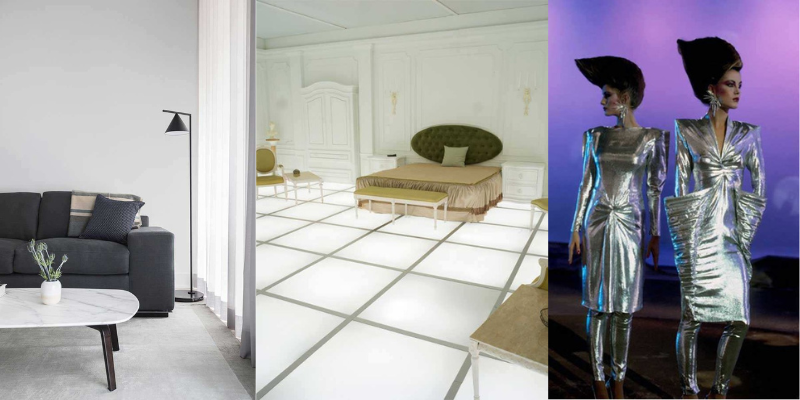Minimalism in design and pop culture has led to a decrease in the use of colour.
Dr. Cath Sleeman, a research fellow at the Policy and Evidence Centre, recently analyzed over 7,000 photographs of everyday objects from the Science Museum Group Collection. Of all the observations, the increase in grey tones and the decrease in warmer shades have stood out throughout the study. The gradual transformation of colourful objects towards greyer and whiter tones can be understood from the shifts in material use and the age of industrialization. In postmodernism, this trend is observed in cultural preferences through the boom of minimalism in design. While not conclusive in any regard, the study begs the question of whether design, art, science, and technology are propelling the world toward a homogenous minimalist culture.
Gray in Minimalism and Abstract Expressionism

Minimalism is a design style that emphasizes simplicity and the use of a few colours, typically neutral tones and muted shades. Minimalists seek to remove all unnecessary elements, leaving only the essential and functional components. Implementation takes the form of simple geometric shapes, monochromatic colours, and a lack of decoration or narrative content. Minimalism focuses on the purity of form and the exploration of the relationship between the artwork and its surrounding space. Minimalist artworks are often characterized by their simplicity, precision, and industrial or machine-like appearance.

In stark contrast, Abstract Expressionism, one of the most colourful art movements, emerged during the Cold War, strongly influencing social and cultural liberalism. Shifting away from realism, Abstract Expressionism focused on emotional, personal, and expressive content centred around the artist as an individual. This took the form of abstract shapes and gestural brushstrokes that were supposed to convey emotion and explore the artist’s subconscious mind.
Visualizing the Future

Where minimalism emphasizes simplicity and reduction of form, Abstract Expressionism emphasizes spontaneity and the emotional expression of the artist. Artists, designers, and sculptors have played a key role in informing how we move into the future, with minimalism or expressionism guiding our choices. Therefore, to understand the decline of colours, we may need to uncover the vision of the future rendered by artists from both the past and the present.

Fashion is the cornerstone of any cultural zeitgeist. During the Cold War, when Apollo 11 completed its mission to the moon, the cultural output of the West was taken by a scientific fervour. Fashion designers such as André Courrèges, Paco Rabanne, and Thierry Mugler, in their haute couture display, showcased their vision of the future of space-faring humans.
For Courrèges, minimalism was crucial for differentiating the functionality of science from other aesthetics of the time. White was a dominant tone, shapes were more symmetrical, and heavy embroidery was practically non-existent. Paco Rabanne approached this futuristic zeal through an Avant-Garde lens, decorating models with paper, plastic, and metal. However, the most significant correlation between visualizing the future and minimalism could be seen in Thierry Mugler’s cyborg vision. Despite his propensity for colours, Mugler approached his vision of the future with tinfoil-shiny, silver, pleated dresses through belted, gold spacesuits with helmet-style headgear.
While designers have visualized colourful outfits for the future, most retro and contemporary designers have envisioned the future in minimalistic terms. A paradigm shift in fashion can only be noted in an increased preference for darker shades of grey instead of the brightness of whites. Spring 2022 for Fendi, Schiaparelli, and Giambattista Valli were unapologetic in depicting this trend.

In addition to fashion, minimalism has also impacted architecture and home decor. This trend has been alive and well in several monumental buildings worldwide. Observing futuristic designs from the Architectural Digest, nearly all futuristic concepts feature simple geometric shapes and limited use of colour. The only accent of colour is seen in incorporating plants and artificial lights. Furthermore, projects that aimed to produce realistic versions of science fiction utopias also carry blueprints with minimalist renderings. Regarding current-day projects, a cursory look at the NEOM – Saudi Arabia’s planned smart city – shows humanity’s constant, unwavering path toward absolute minimalism.

With the world outside progressing in this manner, the interiors of homes have lost colour in great abundance. In interior design, futurism and minimalism are inseparable. The future is frequently imagined in terms of artificial shapes marked by angular and curved glass, metal, and plastic designs. Despite being inspired by various cultures and periods, furniture also leans into minimalism principles. Electronic appliances and lighting systems focus on portability and functionality while occupying the least space. This phenomenon will likely continue to build on minimalism as we enter the future.

There is an argument to be made that minimalism’s most prominent and influential medium of large-scale transference came from cinema, especially science fiction, where a futuristic vision of the world is often streamlined, sleek, and minimalistic. Many science fiction movies worldwide depict a sophisticated tech-oriented future where design has advanced to the point of extreme simplification, and objects are reduced to their most essential elements. A notable example of this phenomenon can be observed in 2001: A Space Odyssey, directed by Stanley Kubrick. The film features a minimalist design that emphasizes the sleek, clean lines of the white & grey technology used by the characters. The iconic monolith is a perfect example of this minimalist design, with its simple black rectangular shape.

The anime movie Ghost in the Shell, directed by Mamoru Oshii, is another excellent example of how minimalism was used effectively in storytelling and world-building. There is a purposeful use of negative space throughout the iconic anime. Many scenes in the movie feature large, empty spaces to convey a sense of loneliness and isolation. Ghost in the Shell was also known for its distinct lack of colour. The movie primarily used shades of blue and grey, with the occasional pops of red, yellow, and green. This limited colour palette creates a mood of detachment and unease, emphasizing the coldness and sterility of the futuristic world. Its design elements, buildings, technology, and vehicles were grey, emphasizing their efficiency and functionality.
The characters’ clothing and hairstyles were also uncomplicated and efficient, conveying a sense of futuristic fashion. Cinema has unequivocally helped popularize minimalism by presenting it as a desirable and achievable vision of the future. As a result, these movies have played an essential role in inspiring people to adopt minimalist lifestyles and design aesthetics.
The Impact of Grey on Psychology & Society

Colour has been shown to significantly impact mood and emotion, with bright colours often associated with happiness and joy. However, a research article in the International Journal of Applied Positive Psychology found that the impact of minimalism on well-being yielded much more positive results. This research did not focus on the decrease of colour, yet the large-scale absence of it through reduced décor is of notable significance. Another consequence cited by researchers is a loss of creativity. Designers may struggle to create innovative designs with fewer colours and design elements.
This can lead to an increasingly stagnant world with little room for creativity or experimentation. Yet, considering ecological and sustainable design initiatives, most designers prefer to mute the impact of human technology while embracing the colours of nature as a utopian setting for future ecosystems. This inclination can be traced to theories of posthumanism, where human activity is aligned and part of the species’ natural surroundings.
On a global scale, researchers fear several potential consequences of the decreasing use of colour. One of the most cited adverse effects is the loss of cultural diversity. Colours are often an essential part of cultural identity, with different cultures placing different meanings on different colours. As the use of colour decreases, there is a risk that cultural diversity will be lost, leading to an increasingly homogenized world. A lack of colour is colloquially termed chromophobia. It has been linked to societal vices such as colonialism and racism, wherein colourful communal preferences are considered inferior to European standards of colour neutrality. Nevertheless, countries such as China, India, and Mexico, known for their vivid cultural practices, have begun to embrace minimalism while incorporating their unique aesthetic into the principles.

In the same vein, afro-minimalism has re-defined fashion trends for the majority of the African continent. Ghanaian designer Travis Obeng-Casper champions a significant departure from the overused minimalism trope of brushed metal, light tones, and Nordic pine woods while centring the diversity, sustainability, and cultural significance of African clothing. These processes include traditional design techniques and Africa’s rich history. While it may seem that a decrease in colour can lead to a dull, homogenous world, these unique adaptations showcase more potential for innovation in the field.
Minimalism of Color: Conclusion
The minimalism of colours positively affects humanity through reduced visual clutter, increased clarity, and improved accessibility. Furthermore, the decrease in manufacturing colours and chemicals supports environmental goals. However, it is essential to note that colour positively affects mood, emotions, and overall well-being. Some may find a lack of colour dull or unstimulating, while others may find it calming or peaceful. Additionally, cultural and personal associations with different colours can vary in terms of effects on individuals. It may be termed a trend or an insignificant phenomenon, but going grey is the trajectory we have been on for several decades unanimously, and perhaps unconsciously, as a collective.
Read Also:

Contributor





